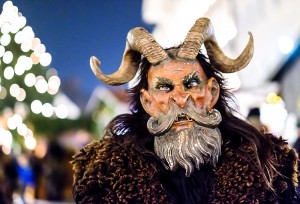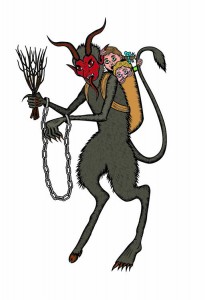Krampus Kringle
When thinking of the Christmas holiday, many think of Saint Nicholas. Did you know he had a beastlike companion who disciplines naughty children? The Krampus is a figure in the Christmas folklore of the central European nation of Austria. Krampus didn’t dole out coal, it often threatened ‘bad’ kids with physical punishment. Krampus was modeled after the Christian Devil, also known as Satan, and northern European gods whose worship predated the introduction of Christianity in the region. The name Krampus comes from the old German word krampen, meaning claw.
Krampus originated in the Middle Ages (about the 400′s through the 1400′s), when the famous bishop St. Nicholas became a popular gift-giving figure. Traditionally, St. Nicholas brought presents to well-behaved children on December 5 or December 6, his feast day. Medieval Christians also created a companion for St. Nicholas to discipline badly behaved children, as they pictured the Devil punishing sinners. The companion served as a sort of alter ego of St. Nicholas—that is, another aspect of his nature, or a close associate. This tradition was especially popular in central and eastern Europe. The companion was known as Knecht Ruprecht (Servant Rupert) or Belsnickel (also spelled Pelznickel or Belsnichol) in parts of Germany, Schmutzli in Switzerland, Zwarte Piet (Black Peter) in what is now the Netherlands, and Krampus in Austria.
Among the different versions of St. Nicholas’s companion, Krampus was especially frightening. Images of Krampus show him with large, goatlike horns; a long tongue and sharp teeth; and hooves on one or both legs. Some accounts describe Krampus with an empty basket on his back, for carrying away naughty children. In some descriptions, Krampus carries chains, and holds a whip or birch twigs for beating children.
The purpose of Krampus was to scare children into being good. Accounts about St. Nicholas describe the bishop as intervening on behalf of naughty children so that Krampus did not actually harm them. St. Nicholas would scold a naughty child, usually a boy, and tell him that he had to change his ways and obey his parents. Over time, Krampus became a less frightening figure. In the 1800′s in Austria, accounts described Krampus as accompanying St. Nicholas through village streets and to children’s homes, suggesting that he was not really all that dangerous.
In some parts of the world, St. Nicholas developed to become the jolly figure of Santa Claus. Santa’s only associates are elves who make toys and visit with children in department stores at Christmastime. However, the Krampus tradition has survived. Some communities in Europe hold Krampus events on December 5, known as Krampusnacht (Krampus night). People dress up as Krampus and celebrate in the streets. Krampus also has been the subject of novels, television programs, video games, and even a motion picture called Krampus (2015).




